
By William Van Zyl (2019)
Table of Contents
Overview of this article
From a sustainability perspective, this article investigates the views of three prominent cultures: Hinduism, Māori World view (New Zealand’s indigenous people), and Christianity. By comparing the different cultures or perspectives, the concept of giving rights to natural features like rivers are discussed. However, there are many more world views – or religions – to consider; the three mentioned are used to speak on behalf of all the different perspectives or opinions in our world. The three views contrast the different approaches or reasoning when interpreting the idea of river rights. Understanding the different philosophical views or premises from which people view the world – or reality – is essential. In this article, I call for a unified approach to accept others’ perspectives and views; to develop an attitude of working together for the environment. The world is a global village, and it is challenging to unify diverse ethnic groups, cultures, and races in a specific country or region. In this article, the focus is the rights of rivers and the responsibilities that follow.
At the start, we will look at the Hinduism perspective and specific the Ganges River of India. Secondly, the Māori World view will be explored, and the rights of the Whanganui River – awarded in 2014 (New Zealand) will be discussed. Finally, a Christian or Biblical view will be investigated.
Introduction
The Ganges River in India
About 2,000 million litres of sewage flows into the Ganges River (in the vernacular Ganga) – located in India – every day. Think about that. Every day every week, every year. Year after year. Imagine the impact on the river and its surroundings. The newly re-elected president of India – Narendra Modi (May 2019) – has promised to do something about the pollution of the Ganges River a couple of years ago. Since then, no progress has been made. The Ganges River in India is one of the world’s most polluted bodies of water. Are the citizens killing the river? Can the river handle this flow of sewage; you may ask? If the Ganges River could talk, what would it say to us?
Over and above the sewage, the ashes of thousands of Hindus and partially scorched human remains are dumped into the Ganges every day. Birds and dogs scavenge all day and night long. The Hindus of India believe they can break the perpetual cycle of samsara. It is the cycle of birth and rebirth (reincarnation); thus, they strive to achieve moksha – eternal liberation.
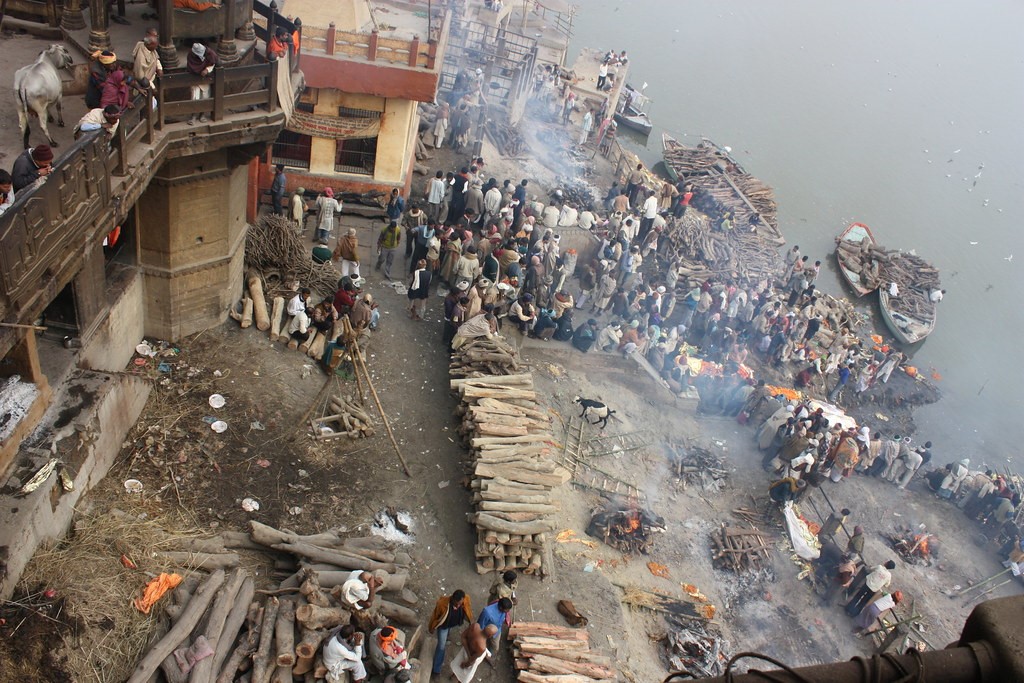
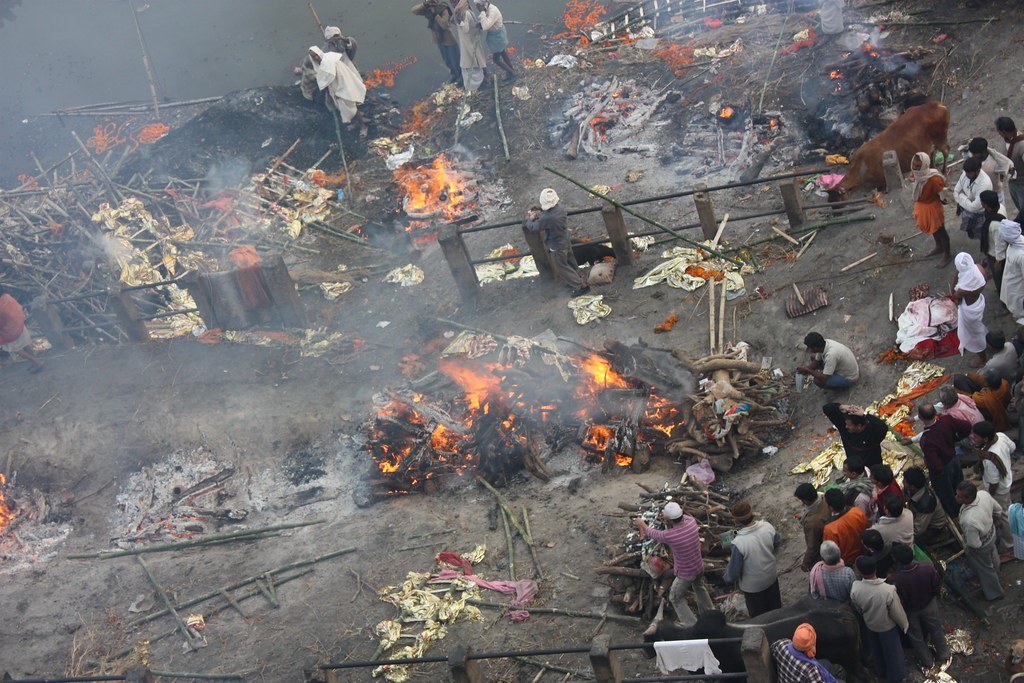
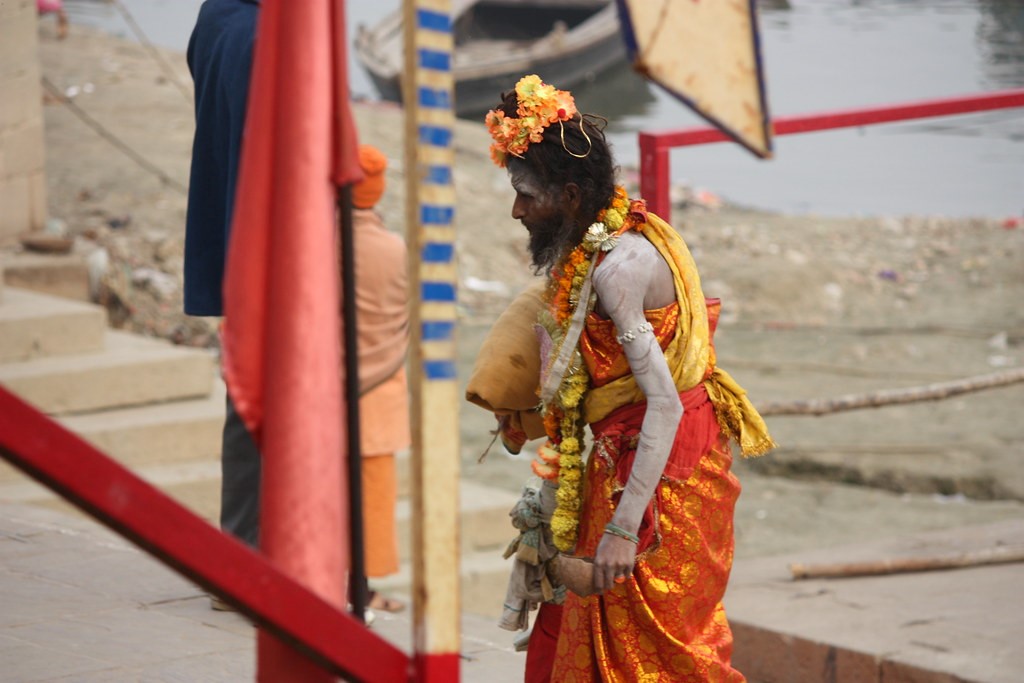
Location: Varanasi, Manikarnika Ghat (India)
Hindus Cremation of the dead.
Varanasi (also known as Benares, Banaras, or Kashi), is a North Indian city on the banks of the Ganges river in Uttar Pradesh, India. Varanasi is one of the oldest continuously inhabited cities in the world. The spiritual capital of India, it is the holiest of the seven sacred cities (Sapta Puri) in Hinduism and Jainism and played an important role in the development of Buddhism.
Buddha is believed to have founded Buddhism here around 528 BC when he gave his first sermon, “The Setting in Motion of the Wheel of Dharma”, at nearby Sarnath. The city’s religious importance continued to grow in the 8th century when Adi Shankara established the worship of Shiva as an official sect of Varanasi. Despite the Muslim rule, Varanasi remained the centre of activity for Hindu intellectuals and theologians during the Middle Ages, which further contributed to its reputation as a cultural centre of religion and education. In the 16th century, Varanasi experienced a cultural revival under the Muslim Mughal emperor Akbar who invested in the city and built two large temples dedicated to Shiva and Vishnu, though much of modern Varanasi was built during the 18th century, by the Maratha and Bhumihar kings. The kingdom of Benares was given official status by the Mughals in 1737 and continued as a dynasty-governed area until Indian independence in 1947.
Varanasi has been a cultural centre of North India for several thousand years and is closely associated with the Ganges. Hindus believe that death in the city will bring salvation, making it a major centre for pilgrimage. The city is known worldwide for its many ghats, embankments made in steps of stone slabs along the river bank where pilgrims perform ritual ablutions. Of particular note are the Dashashwamedh Ghat, the Manikarnika Ghat, the Panchganga Ghat, and the Harishchandra Ghat, where Hindus cremate their dead.
Manikarnika Ghat is the primary cremation ghat in Varanasi, and one of the oldest ghats in the city.
Source: Arian Zwegers (Flickr)
https://www.flickr.com/photos/azwegers/6291880051
Setting an international example: The Whanganui River in New Zealand receiving ‘rights’ in 2014.
The Whanganui River in New Zealand is the first river in the world to be bestowed with legal personhood (2014), it is no longer the only one. Merely five days after the Te Awa Tupua (Whanganui River Claims Settlement) Bill passed in the House, India’s Uttarakhand High Court granted the same legal personhood to the river Ganges – perhaps showing just how influential and innovative New Zealand’s approach is. Let us look at the spirituality of India and how the Ganges River fits into their religious rites.
A Spiritual Perspective on the Ganges
In 2017, India’s National Green Tribunal issued new, strict regulations aimed at cleaning up the Ganges. According to Indian mythology, the Mother Ganges (Ganga) is a goddess who long ago descended from the sky to resurrect the ashes of an ancient king’s ancestors. Any Hindu who dips in or drinks from her is freed from a great deal of karmic debt. Furthermore, anyone whose remains are scattered in her escapes immediately from the cycle of reincarnation. She is also the most respectful resting place for the carcasses of cows.
India’s revered Ganges and Yamuna rivers cannot be viewed as living entities, the Supreme Court has ruled.
It overruled an order made in March 2017 by the High Court in Uttarakhand state, which said that the two rivers had the same legal status as human beings.
The move was seen as a measure to increase protection for the rivers, which are deeply venerated in India but are heavily polluted.
However, Uttarakhand’s state government took the issue to the Supreme Court.
It argued that the declaration was legally unsustainable.
The declaration attracted a lot of publicity. But the state government of Uttarakhand, where the Ganges originates, argued that the ruling simply was not practical and could lead to complicated legal situations, even claims against the rivers in cases of flooding or drowning.
The river Ganges – worshipped in Hinduism as “Ganga Mata” or mother – is a lifeline to more than 500 million people across India. It and its tributary the Yamuna are two of the country’s major rivers. Here are links to articles to provide more depth to the matter of the legal right:
Could making the Ganges a ‘person’ save India’s holiest river?
NZ river first in the world to be given legal human status
BBC South Asia Editor Jill McGivering says they are central to Indian life and much celebrated in Indian culture, even worshipped as deities.
However, both are heavily polluted by industrial waste and sewage – even by the remains of the many bodies cremated on their banks.
There are laws to stop pollution, but critics say they are inadequate and poorly enforced.
Source: BBC News. 7 July 2017. https://www.bbc.com/news/world-asia-india-40537701
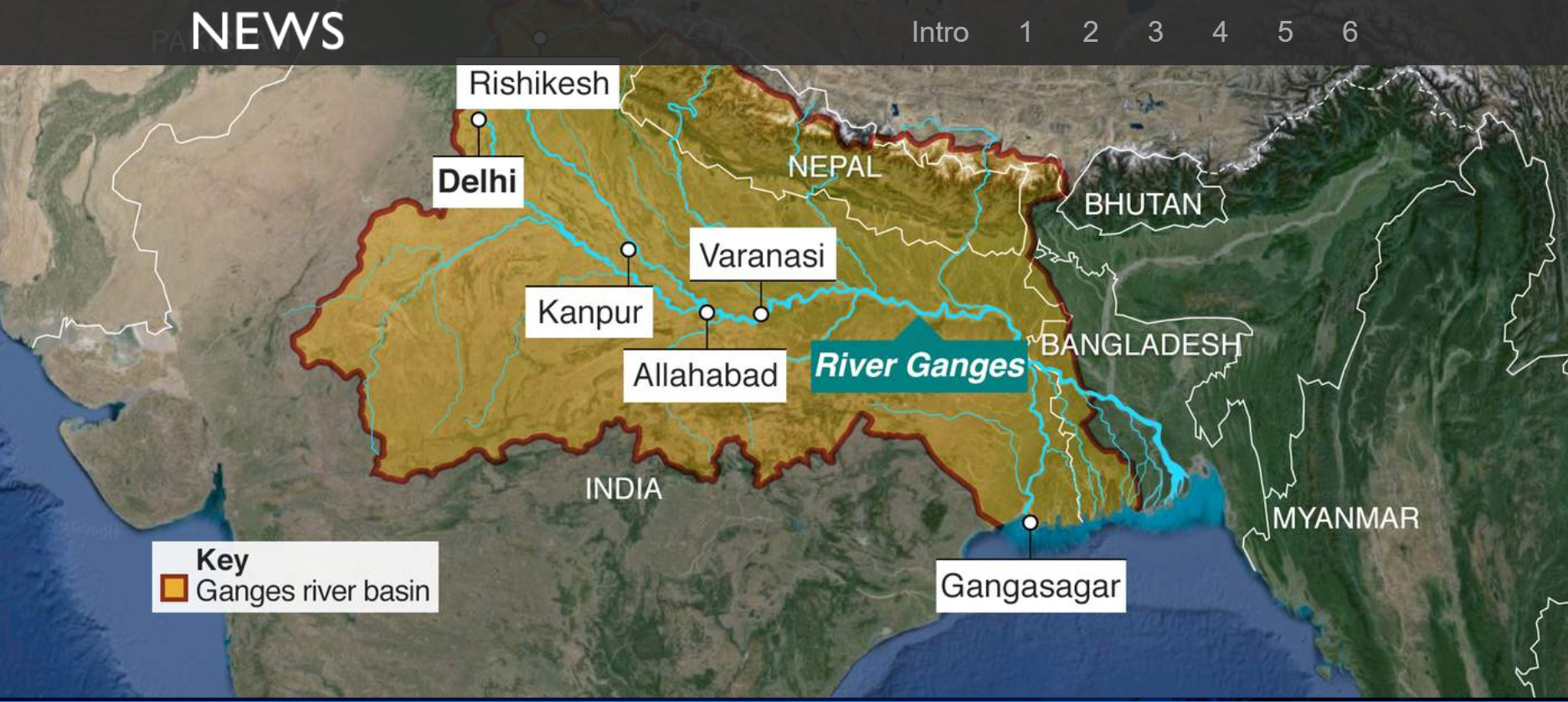
Let’s look at the second worldview regarding the role of the river in a culture.
Māori Perspective of the Environment
Traditionally, Māori believes there is a deep kinship between humans and the natural world. This connection is expressed through kaitiakitanga – a way of managing the environment. Today there is a growing interest in kaitiakitanga as Iwi (tribes) restore their environment and their culture.
Kaitiakitanga means guardianship and protection. It is a way of managing the environment, based on the Māori worldview.
A kaitiaki is a guardian. This can be a person or group that cares for an area such as a lake or forest. They are given that role by the local Iwi.
Kaitiakitanga today
Today there is a growing interest in kaitiakitanga. Iwi is restoring their environment and culture. They are using their traditional ideas and concepts in the modern world. Examples are:
Ngāi Tahu are guardians of pounamu (greenstone) in the South Island.
Te Āti Awa ki Taranaki made a claim to the government to stop pollution in their fishing areas.
Four iwis (Ngāti Kahungunu, Rangitāne, Muaūpoko and Ngāti Raukawa) have come together to stop the Manawatū River being polluted.
The Te Rarawa people are working to save the kūkupa (New Zealand pigeon).
Kaitiakitanga has also been included in some laws, such as the Resource Management Act 1991.
Source: Te Ara. The Encyclopaedia of New Zealand. https://teara.govt.nz/en/kaitiakitanga-guardianship-and-conservation
Māori’s Spiritual Perspectives on the Environment
In the beginning, Ranginui (the sky god) and Papatūānuku (the earth god) were joined together, and their children were born between them in darkness… After this, the children became gods of various parts of the natural world. For example, Tāne became the god of the forests and Tangaroa the god of the sea. These are the Māori gods and demigods related to nature or the environment.
Source: Te Ara. The Encyclopaedia of New Zealand. https://teara.govt.nz/en/Māori-creation-traditions
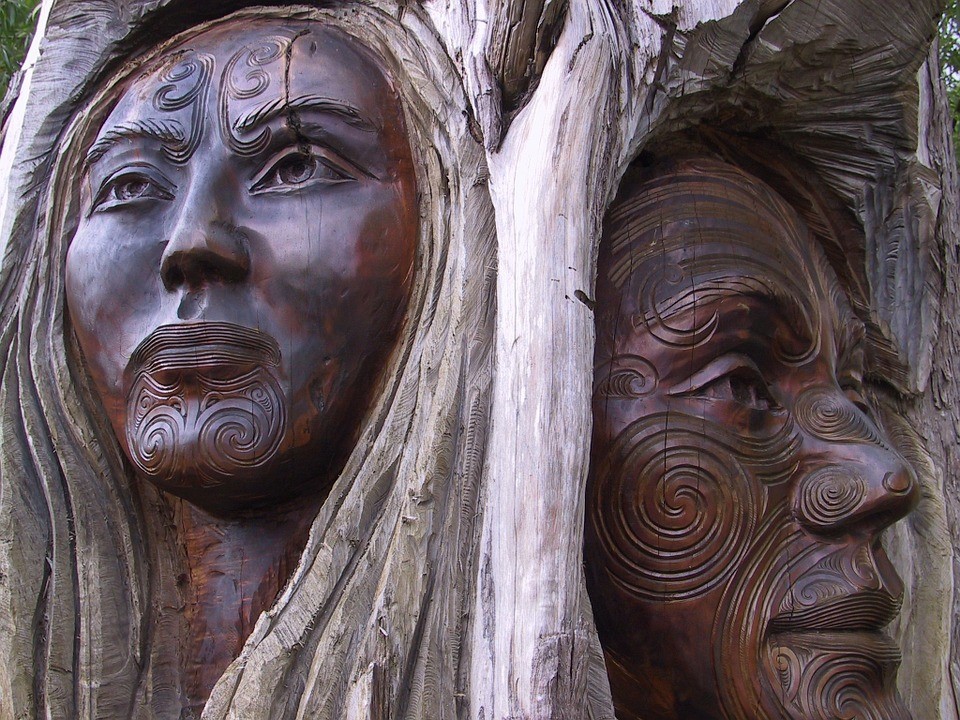
Let us look at the Christian world view and the matter of rivers and river rights.
A Christian World View or Perspective on Sustainability and Sustainable Practice
Some believe that humankind has a God-given right to consume. However, few people consider the broader global ramifications of industrial activities like strip mining, fracking or burning fossil fuels. As a result of these practices and other unsustainable approaches, our oceans are sick, large sections of our forests have been swathed, and the air we breathe is polluted – this has been the modern human interpretation of “rule” or “dominion” over the world. As reported in this article, the new way of looking at the rivers (and now mountains) is to see them as living entities. Is this an effort to break the cycle of abuse to the environment by humans? Firstly, let us consider the term dominion from a holy writ perspective.
In the book of Genesis, the Creator said, ‘Have Dominion over the Earth!’ In other words, rule over it. On the question, should a river or could a river have rights, the answer is very clear resounding yes. Yes, it can! Humans have received the authority by the Creator Himself to make plans, make decisions, strategise, and take action. Even legal action.
Then God said, “Let us make mankind in our image, in our likeness, so that they may rule over the fish in the sea and the birds in the sky, over the livestock and all the wild animals, and over all the creatures that move along the ground.” – Genesis 1:26
Giving river rights is exercising the freedom to rule over rivers and the benefits they provide. Humans thus have the authority and right to allocate legal rights to a river. Remember, with rights come responsibilities. So, what could rivers responsibilities be? Providing water to farmers? Providing fish (food) to locals on the sides of the river? Proper draining of the basins (land) around the river (precipitation)? Providing safe travel by boat (transportation)? Can you name any more?
The question of why should we give river rights could be answered as follow:
‘River rights are necessary to protect the environment against human exploitation, contamination, and pollution. By taking strong action for the river (environment), we defend the river against unsustainable practices and consequential ruin. In this day and age, we have to take drastic action – legal action.’
When rights are awarded, it also implicates responsibilities. So the question is: ‘What are the responsibilities of the river as a legal entity?’ In the broadest sense, the river has no choice in what happens to it. It allows water to flow from the highest areas to the lowest place (usually the ocean). As it is designed to do. According to the water cycle – also called the hydrological cycle – water evaporates from the land and the sea, clouds are formed, and it rains (precipitation) back to the earth. This is a continuous cycle. The water flows from the highest areas to the lowest areas via rivers and streams. The duty or responsibility of the river is to channel surface water. Furthermore, it has to sustain life in the river (e.g. fishing/food), including microorganisms, insects, water, plant life and more. Its responsibilities go further; it has to provide and sustain life to the surrounding areas – both sides of the river.
In return, then, the river has rights for the sustaining role it plays. Those rights could look like:
· The right not to receive uncontaminated water like effluent (e.g. weed killer, high volumes of nitrogen, poisons, factory waste, harmful chemicals, and more). Remember, it has to fulfil its responsibilities!
· The right to produce an optimal level of support to all the living creatures, fish, and plants in the river and the banks of the river. As the rivers were designed to do.
· The right to discharge ‘healthy’ (uncontaminated) water into the ocean (the river’s friend and neighbour). A legal prerequisite – if the ocean has rights. Should the ocean have rights to protect it against the river, and consequently, people?
· Can you list more?
Defining Dominion: Looking at the river from a Christian perspective.
It is inconceivable to think that “dominion,” in a Biblical context, means stewardship. The English word for “stewardship” comes from the Greek word “oikonomia”, which means “the management of a household or household affairs.” The household, in this case, refers to the Earth, “our only home,” as Carl Sagan once said. Scripture clearly states that God created the Heavens and the Earth, so by that logic, don’t we all have a divine mandate to protect it? A growing number of theologians are witnessing dramatic changes to the earth’s climate. As a result, they are now asking questions that challenge business as usual. Dominion is not domination.
The book Ezekiel talks about a river that flows from under the threshold of the temple. The water flows and creates fresh water. Everything that the river encounters lives. Beautiful, healthy trees are on the sides of the river. Water creatures, other creatures, and fish come alive. Fishers cast their nets and collect more than enough. Fruit trees of all kinds grow on both banks of the river. Their leaves do not wither, nor do their fruit fail. Every month they bear fruit because the water from the sanctuary (temple) flows to them. Their fruit will serve for food and their leaves for healing. What a beautiful description of a pure, uncontaminated, living river. It explains the duties or responsibilities of the river.
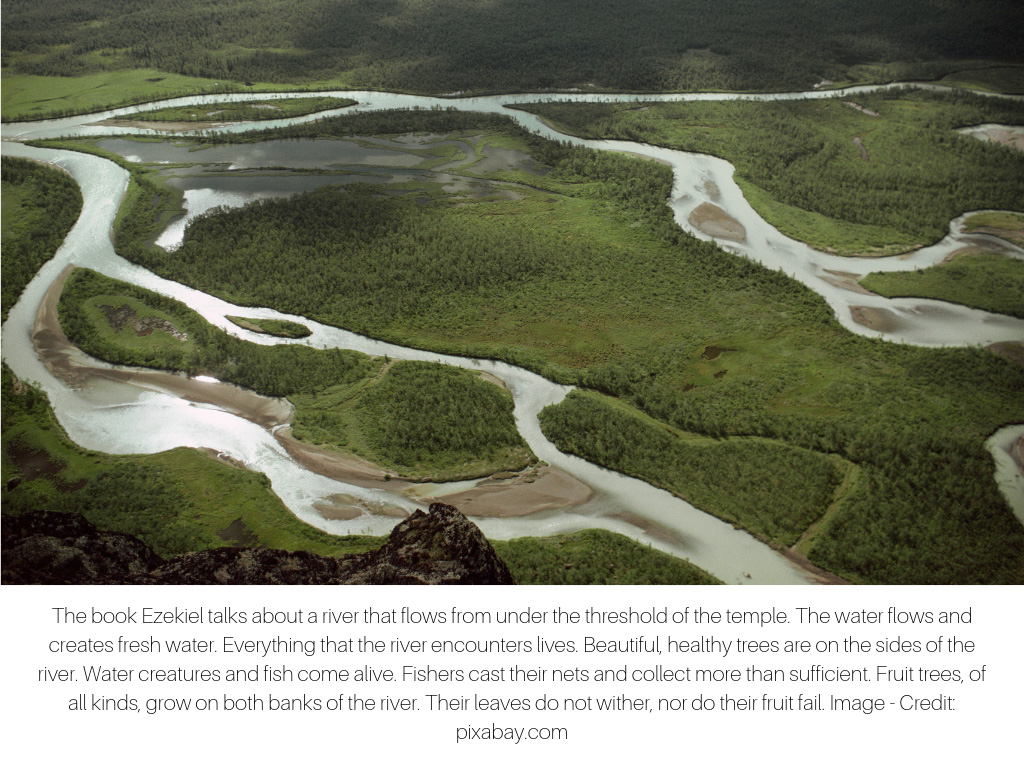
The River from the Temple
Ezekiel 47
1The man brought me back to the entrance to the temple, and I saw water coming out from under the threshold of the temple toward the east (for the temple faced east). The water was coming down from under the south side of the temple, south of the altar. 2He then brought me out through the north gate and led me around the outside to the outer gate facing east, and the water was trickling from the south side.
3As the man went eastward with a measuring line in his hand, he measured off a thousand cubits and then led me through water that was ankle-deep. 4He measured off another thousand cubits and led me through water that was knee-deep. He measured off another thousand and led me through water that was up to the waist. 5He measured off another thousand, but now it was a river that I could not cross, because the water had risen and was deep enough to swim in—a river that no one could cross. 6He asked me, “Son of man, do you see this?”
Then he led me back to the bank of the river. 7When I arrived there, I saw a great number of trees on each side of the river. 8He said to me, “This water flows toward the eastern region and goes down into the Arabah, where it enters the Dead Sea. When it empties into the sea, the salty water there becomes fresh. 9Swarms of living creatures will live wherever the river flows. There will be large numbers of fish, because this water flows there and makes the salt water fresh; so where the river flows everything will live. 10Fishermen will stand along the shore; from En Gedi to En Eglaim there will be places for spreading nets. The fish will be of many kinds—like the fish of the Mediterranean Sea. 11But the swamps and marshes will not become fresh; they will be left for salt. 12Fruit trees of all kinds will grow on both banks of the river. Their leaves will not wither, nor will their fruit fail. Every month they will bear fruit, because the water from the sanctuary flows to them. Their fruit will serve for food and their leaves for healing.”
What is the meaning of Ezekiel 47:
“In Ezekiel chapters 40-48 we read of the visions that God gave to Ezekiel of the coming Millennial Kingdom of the Lord Jesus Christ. In chapters 40-42 he was given a description of “the Temple” that will be built; in chapters 43-46 “the Temple Worship” is described; and in chapters 47-48 he was shown a vision concerning the “Land” of Israel. In short, the “Land” is going to be blessed beyond what one could imagine. In 47:1-12Ezekiel saw a marvelous vision of a RIVER OF LIFE that would begin in the Holy of Holies and make its way through the Temple and flow outward down to the Dead Sea. The passage is too long to quote, but I would encourage you to read the portion. Many have wondered if this river is to be taken literally or symbolically. We believe it will be a “literal river,” but that it also has a “symbolic meaning.” Source: answersfromthebook.net – http://answersfromthebook.net/can-you-please-explain-ezekiel-471-9/
One could reason that the rights of the river – in a Biblical context – is to stay pristine, healthy, and uncontaminated. By enforcing the rights of the river – the rivers belong to the Creator from a Biblical perspective – is, in fact, respecting the creation of Jehovah God. With this mindset of guardians and managers (not owners) of the river (‘the environment’), we are mere overseers of nature. In the beginning, it was handed to us in its purest form. Let us keep it that way. Our duty is to maximise the potential of the river. In other words, keep the rivers healthy, clean, and alive. We are managers and stewards of the river (and the rest of the environment) – we are not the owners.
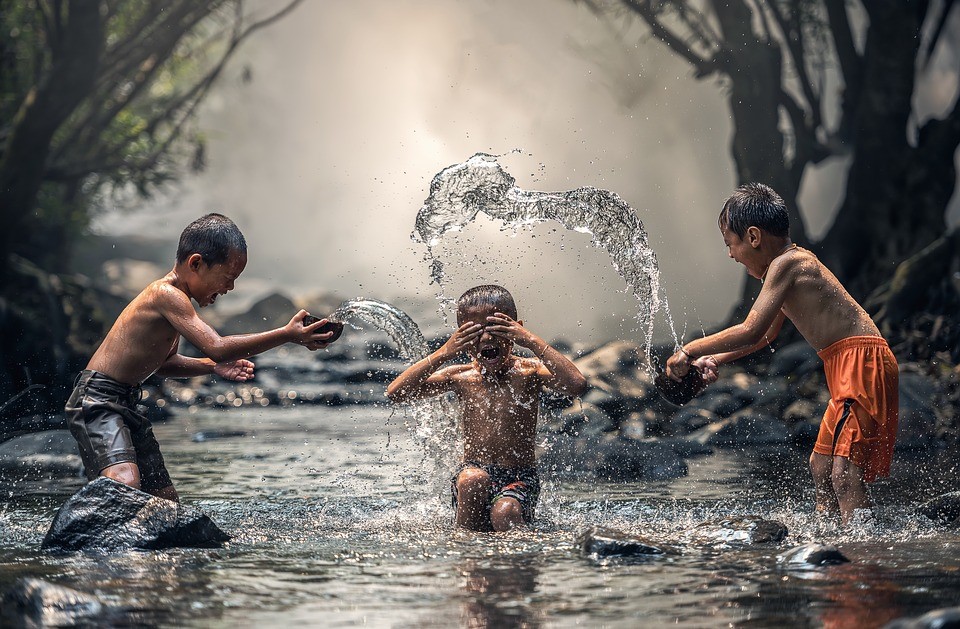
Conclusion:
When comparing the three chosen perspectives, namely Hinduism, a Māori worldview, and Christianity, it is clear that the multi-dimensional societies, which we live in today, have to work together in a unified community. The effort to keep and restore the health of our rivers is our responsibility. Our life and the life of our rivers are at stake. More worldviews like Buddhism, the Sikh religion, and the Muslim faith need consideration; these views are not excluded from this discussion. The discussion was limited to three views for this article to keep it simple and to the point. It means that the different philosophical perspectives (religious code) should be respected and acknowledged by everyone in society. When cultural differences are honoured, it reinforces the unity within a country or the region. Tolerance, acceptance, care, and the acknowledgement of different worldviews and religion is essential for peace and stability. We should never forget that freedom of expression and freedom of religion is a human right. Let us lead the way by being tolerant and inclusive. Let us and take action for the environment.
If the three different religions discussed here are present in a country or region where river rights are to be awarded, the three perspectives should be respected. There would probably be more different views in a country or region as people migrate. If the river has a history (culture) with a specific group, the remaining groups should accept the history and the culture associated with that particular river. However, different religious groupings should be allowed to view the river differently (personal interpretation). The critical matter is that the river should be respected. We should do everything in our power to keep it clean, pure, and pristine, just as ‘Mother Nature’ has intended it to be. Respect the rights of the river. The appointed guardians of the rivers with rights should manage rivers to maximise the benefits to every living creature! For example, the Whanganui River in New Zealand has two guardians, a member of the Iwi (Māori) and a member of the Crown. The Whanganui River – which received its river rights in 2014 – are now protected by law. We manage the rules and regulations.
Strong unity within a diverse society depends on acceptance, inclusivity, and tolerance of one another. Let us practice the role of co-guardians in our various communities!
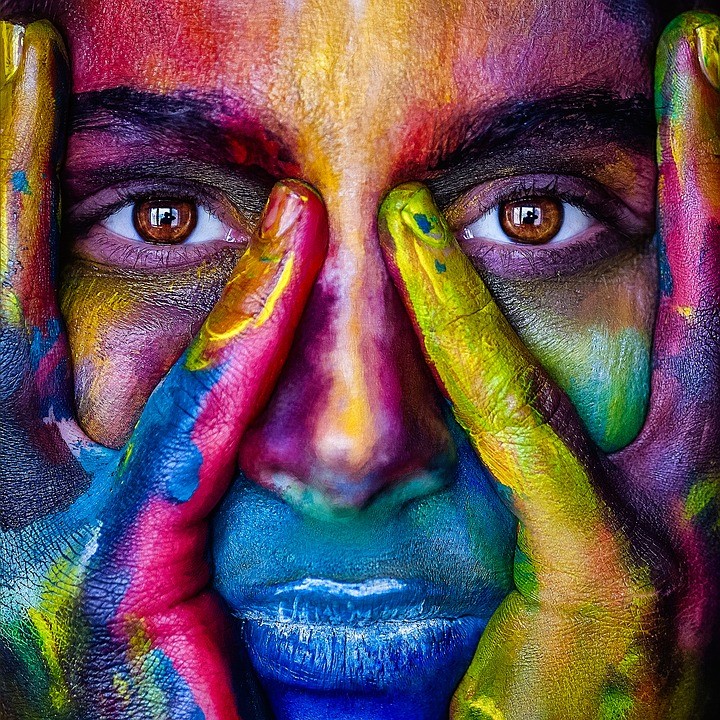
References:
BBC News (article). 7 July 2017. https://www.bbc.com/news/world-asia-india-40537701
BMC Series Blog: Cleaning up a public health threat – the River Ganges
Ganges River Pollution. https://gangapollution.weebly.com/health-effects.html
New Zealand Parliament: Innovative bill protects Whanganui River with legal personhood. Published 28 March 2017.
Te Ara. The Encyclopaedia of New Zealand. https://teara.govt.nz/en/Māori-creation-traditions
Te Ara. The Encyclopaedia of New Zealand. https://teara.govt.nz/en/kaitiakitanga-guardianship-and-conservation
Urban Fabrik. Connecting policy with practice and design. A Biblical Case for Sustainability. https://urbanfabrick.com/a-biblical-case-for-sustainability/
Varanasi, the spiritual capital of India – YouTube:
https://www.youtube.com/watch?v=cI-aJmAWEDk
Explore more:
About the author: http://williamvanzyl.com/
See more ebooks and publications by the author at: https://fivehousepublishing.com/
Copyright
Copyright © 2019 by William Van Zyl
River Rights: A United Approach to Improve Sustainable Practice.
All rights reserved. This book or any portion
thereof may not be reproduced or used in any manner
whatsoever without the express written permission of the
publisher except for the use of brief quotations in a book review.
Published by Five House Publishing (New Zealand)
First Publishing, 2019
